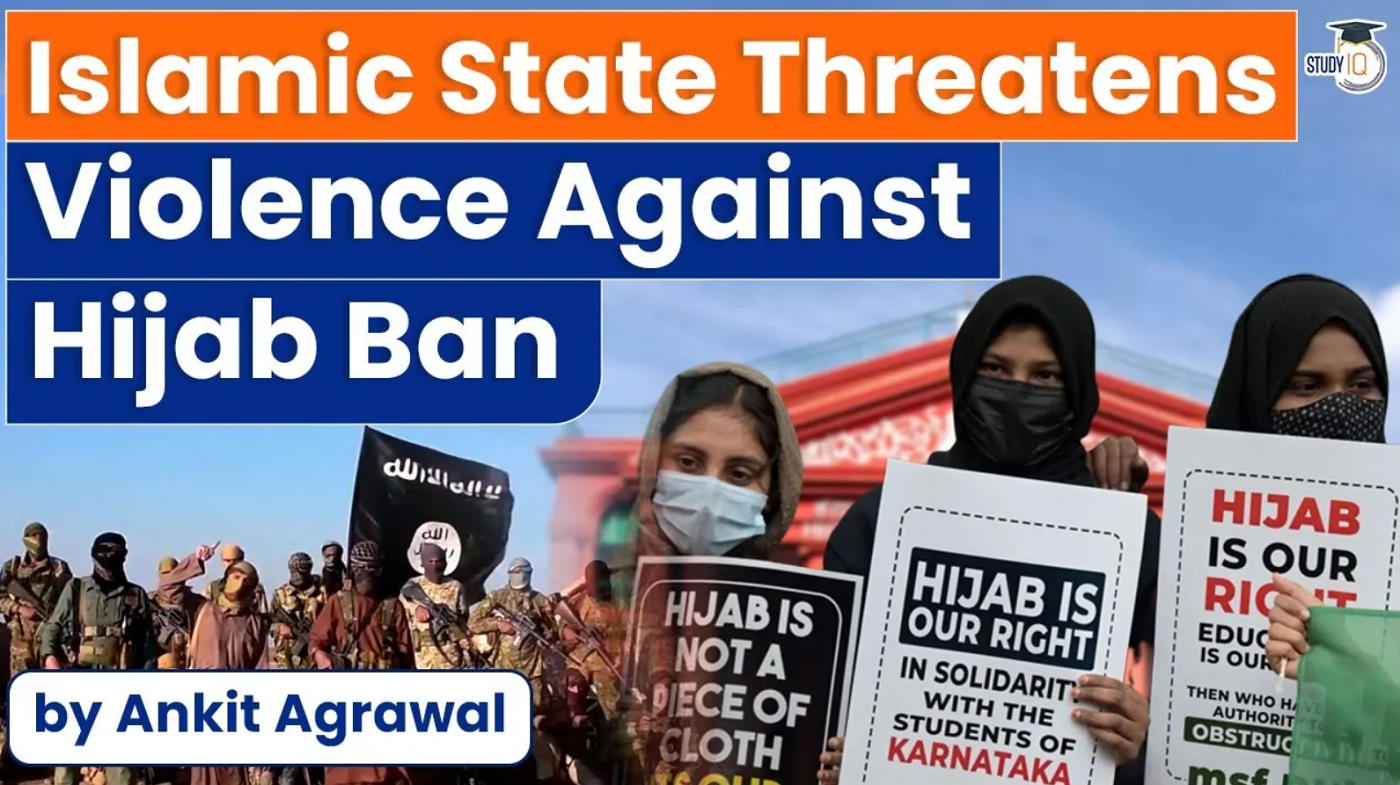Table of Contents


What has happened?
- The Islamic State (IS) terror group has commented on the Karnataka hijab controversy in its propaganda magazine Voice of Hind, Alleging that the ruling Bharatiya Janata Party (BJP) planned the “discriminatory ban on hijab to undress and humiliate Muslim women publicly”.
- The party, it alleged, was using the hijab issue to “disempower young Muslim women and segregate students on lines of religion”.
- “Every Hindu coward putting an eye on the honour of our sisters will be slaughtered into pieces mercilessly,” said the magazine’s March issue, which was released on the IS’ encrypted online platforms.
Global conspiracy
- The magazine said the Karnataka hijab controversy was part of a global conspiracy to “demonise Muslims”, and claimed that, India was following countries like France, the Netherlands and Switzerland in forcing Muslims to “assimilate with the rest of the population”.
- “The fact that world politics has focused its guns on the Muslim communities in their respective countries is the clear indication of the collective propaganda to turn one community into the common enemy so the real issues are left unquestioned,” the magazine claimed.
- The arguments in Voice of Hind resemble those made by some groups in India that have been critical of efforts to prevent the hijab in schools and colleges.
- For example, an open letter by 2,000 intellectuals, including lawyers, journalists, academicians, and women’s rights activists — which was released in February — had sought action against “Hindu supremacist” groups who were “boycotting Muslims on various pretexts”.
- The letter had also argued that the hijab was the latest pretext to impose “apartheid” against Muslim women.
- The Voice of Hindmagazine argued that Muslims needed to understand that only a “Caliphate” would guarantee and protect the rights of women.
- “A disciplined and collective struggle must be waged for the establishment of Islamic rule,” it said.

- Within days of the elimination of the first caliph of the Islamic State of Iraq and Syria (ISIS), Abu Bakr al-Baghdadi, in a US raid in Syria in October 2019,
- The group named Abu Ibrahim al-Hashemi al-Qurashi its new caliph.
- On February 3, 2022, US forces claimed the elimination of al-Qurashi in a similar raid in Syria.

- Last week, confirming the death of al-Qurashi, ISIS named one Abu al-Hasan al-Hashemi al-Qurashi as its third Caliph.
- Although details of his identity were not revealed, media reports suggest he is older brother of al-Baghdadi, and a key member of the shura or consultative assembly.
The concerns
- While the February 3 raid would have provided rich information to further disrupt ISIS, the trajectory of the group since the loss of the so-called caliphate and its first two caliphs,
- Suggests that ISIS core based in Iraq and Syria continues to pose formidable risks to the region and the world at large.
- ISIS has continued to show the ability to mount external attacks as far as the Philippines, Indonesia, and Sri Lanka, and inspire frequent attacks/plots, especially in Europe.


- It is reported that ISIS still holds tens of millions of dollars, and has regular sources of revenue.
- The ISIS provinces beyond Iraq and Syria appear to be independent local groups, which are using ISIS platforms and its brand value to recruit locally or regionally.
- The ISIS propaganda machine has utilised opportunistic claims to keep its flag flying.
What next?
- The Ukraine crisis is likely to break the coordination the US had with Russia against ISIS in Syria.
- On the other hand, the ISIS core looks energised.
- The new caliph, who is believed to have been a close confidant of al-Baghdadi, has been moving across Iraq, Syria, and Turkey for the group’s activities.
- It is possible that the third caliph may unleash new communication and operational strategies that are well-adjusted to new geopolitical realities.
- The impact would be felt across the world through a few, but regular external attacks, inspiration to lone wolf jihadis, and ISIS platforms carrying opportunistic claims by self-styled ISIS branches pledging allegiance while pursuing their own local agendas.
- The Islamic State Khorasan Province (ISKP) is one such branch which has, until 2020, recruited foreign fighters from the region and beyond, and used them largely in Afghanistan.
- More such branches are likely to emerge or be re-energised, and pose fresh threats to South Asia and beyond.


Q) Which of the following is correct regarding Supreme Court of India?
- It was constituted in 1950.
- Only SC can hear appeals from the court martial.
- 1 only
- 2 only
- Both 1 & 2
- None of the above






















 WhatsApp
WhatsApp